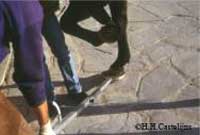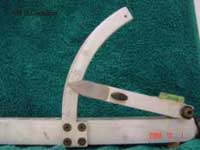
How to use a digital extension device in lameness examinations |
|||||||||||||||||||||||||||||
Introduction:Many clinicians use dorsal digital extension tests, when doing a lameness examination of the front limbs. Traditionally, the limb under examination is placed on the extremity of a long board, while an assistant picks up the contra-lateral limb. The opposite end of the board is then slowly raised, extending the digital joints, tensing the deep digital flexor tendon (DDFT), its inferior check ligament and the collateral and impart ligaments of the distal sesamoid (D.S.), as the palmar angle of the DDFT around the navicular bursa and the D.S. increases. Apart from practical problems like bending or breaking boards, pinched fingers, and slipping of the subject's foot, evaluation of positive or negative responses are only standardized, if at all, with a personal protocol, e.g. by using always the same board, careful placing of the foot at its extremity and deciding on a height to be reached at the opposite end (e.g. The examiner's knee) [1] . Horses show they are getting close to maximum tolerated extension, first by the shivering of their cleidobrachial and extensor carpi muscles, followed by the shifting of their weight on to their hind quarters, inclining their cannon bone backwards. In rare cases the heels will start lifting of the board. Maximum tolerance is therefore determined by slowly raising the board, till the horse shows any of these signs, of which specially the weight shifting, is easily perceived by the clinician, indicating that the horse is about to jump off. Elevating the foot sideways with the use of a board, either laterally or medially, is sometimes done by clinicians, to evaluate tolerance to lateral or medial elevation. This may be useful in the diagnosis of arthrosis - arthritis in the digital joints, painful collateral ligaments of these joints or of the D.S., sources of subcondral pain with a lateral or medial location in the joints and lesions of the distal part of the DDFT, within its lateral or medial lobes. These structures are often injured, as we now know, thanks to magnetic resonance imaging and sophisticated ultrasound studies which have widened our understanding of “Navicular syndrome”. [2] It is interesting to note, that lateral or medial elevation of the foot, does not only cause movement, pinching and tensions in the frontal plane (side to side) of the proximal, and especially the distal inter phalangeal joints (PIP an DIP). There is also torsion in the horizontal plane, with a strong rotational movement of the distal phalanx (PIII), relative to the intermediate phalanx (PII) and the D.S.. This movement has been elegantly studied in vitro and described with the name of colateromotion. [3] From the above it can be concluded, that digital extension test are certainly not very specific (as to the exact site of pain or lesion), and until now not even very sensitive, although this certainly varies with the experience of the clinician. This does not necessarily diminish the practical value of digital extension tests, especially in regard to some treatment options, as for instance therapeutic farriery. It is for example likely, that a horse with a (perceived) intolerance to dorsal extension of the digit, will benefit from specific farriery techniques which facilitate dorsal break over. [4]
|
|
||||||||||||||||||||||||||||
Materials and Methods:To increase the ease of use, and specially the objectivity and sensitivity of the digital extension test, by making it quantifiable, the author developed a graduated digital extension device [DED] a . The DED consists of three round plates, of which the middle one attaches to a 4x4x120 cm long handle. At its opposite extremity the handle has a rubber covered grip, and close to this, a protractor with a needle which incorporates a spirit level. The top plate is covered with rubber to prevent slipping and has a diameter of 21 cm. A set of internal ball bearings permits the middle plate, and its attached handle, to rotate relative to the top and bottom plates. This makes it possible to do a dorsal extension and a lateral and medial elevation on the same limb, without having to replace the foot on the DED; after each measurement the handle is lowered and turned to the next position. The sides of the plates are beveled at a 45° angle, reducing the diameter of the ground surface of the bottom plate to 16,5 cm, making lifting easier for the clinician. When reaching the maximum degree of extension the horse tolerates (dorsally), or when the opposite side of the foot is starting to lift off the plate (lateral and medial elevation), the needle is placed water level, where it stays thanks to a friction device. This permits reading of the measurement on the protractor after the handle is lowered again. The protractor has a c.c. milled scale of 0 - 60°. For ease of transportation (the entire DED is 1,40 m long), the handle can be disassembled in the middle, resulting in two parts of equal (0,70 m) length. |
|||||||||||||||||||||||||||||
Results:To judge the clinical significance of a given extension value in a lame horse, normal ranges in sound horses have to be established first. A recent study of 250 sound horses of different breeds, correlating extension/elevation values with dorsal hoof angle, height, weight, breed, age, sex and use, gave the following results: Dorsal Extension, Mean [CI 95%] (43.18° [+/- 0.93°]); Lateral elevation (18.83° [+/- 0.26°]) and Medial Elevation (19.79° [+/- 0.32°]). The Standard deviations were 7.46°, 2.12° and 2.53° respectively. [5] All horses measured were recently trimmed or shod, so as to eliminate excessive hoof growth as a variable. Repeatability of results was tested by having a subgroup of 50 horses measured again by different testers. The capacity for dorsal extension of the digit in the sound horse is related to conformation and is more variable than the lateral and medial values. Horses with long and oblique pasterns, with low heeled feet (low palmar angles of PIII), like thoroughbreds, have a larger capacity for dorsal extension than horses with short upright pasterns and large palmar angles (e.g. most quarter horses). In lame horses with well matched front feet, a disparity of more then a few degrees in dorsal extension tolerance is significant, and when present, the lower value correlates well with the lame limb. In horses with mismatched front feet, one steep, the other flat, the steeper one has less capacity for dorsal extension (tighter DDFT), so different values are not necessarily abnormal, however anything below 30° should be suspect, even in upright feet. Lateral and medial elevation values are amazingly uniform across breeds and conformation types. Lateral values average nearly a degree less than medial values. This is probably explained by the fact that the test is done on the weight bearing limb, which the horse tends to place under the center line of it’s body, thereby slightly closing the lateral joint spaces. Anything lower than 17° on lateral, and 18° on medial elevation, is considered suspect by the author. The exception being when the low value goes together with an increased elevation value on the opposite side of the same foot. In this case, it is probably a case of mistaken trimming on that particular foot. If, for example, a foot has a lateral elevation value of 16° (the point at which the medial side has started to lift of the plate), but a medial elevation of 23-24°, it is probably a case of lowering the outside wall, relative to the inside hoof wall, by about 3-4° to get normal values and clinical improvement. To put it another way; if the sum of the lateral and medial elevation values is at least 35°, and one of them is decidedly lower than the other, latero-medial joint movement can be improved by trimming on the side of the lower value. If, however, the sum is lower than this, the capacity for latero-medial joint movement has to be considered compromised. |
|||||||||||||||||||||||||||||
Discussion:Digital extension test values do not pin point a specific lesion, but nevertheless have great clinical value. They are extremely useful in shoeing prescriptions, when there is more than one lesion found with diagnostic imaging and to give a rational approach to lateral medial balancing of the foot. Table 1: summarizes therapeutic shoeing techniques for DIP-PIP arthrosis and podotrocleosis in relation to diagnostic and clinical findings (including DED tests), taking the surface the horse works on into account.
When diagnostic imaging reveals more than one lesion in the same limb, witch require, theoretically, opposite therapeutic shoeing prescriptions, the DED lets the horse “talk” for itself, the principle being: facilitate break-over in the direction(s) the lower tolerance to extension/elevation is established. For example, if there are reasons to suspect both a suspensory ligament (SL) desmitis, and a form of podotrocleosis, the horse will show reduced tolerance to dorsal extension, only if the later is clinically more significant then the first. Applying, for example, a blunt-toe egg-bar shoe, is only justified in such a patient if this is indeed the case, as on penetrable ground this shoe will increase fetlock extension. On hind limbs, DED tests, especially dorsal ones, are hard if not impossible to perform, however in the case of proximal SL desmitis it can be use full to perform a standing, weight bearing, flexion test with the DED; the affected hind limb is placed on the DED and the opposite one is picked up, with the handle pointing caudally. When raising the handle, a normal horse will flex it’s DIP joint all the way till it slides of the DED (don’t go over 40°, as this is not risk free). If there is pain from the SL, horses will show intolerance to this weight bearing flexion test, sometimes already in the low 20°s, as DIP flexion increases fetlock extension. These patients will probably not be helped with plantar extensions, like egg-bars. The author has seen the DED used in other creative ways by colleagues, including dynamic tests, whereby the horse is trotted off in a straight line after a timed extension test (e.g. 30 sec. at close to the maximum tolerated dorsal extension), and weight bearing, flexor tendons ultrasound examinations, while raising and lowering the extension device to check for adhesions. Disclaimer: Although the author developed the DED, he has no commercial interests in its distribution or sale. References:
|
|||||||||||||||||||||||||||||



